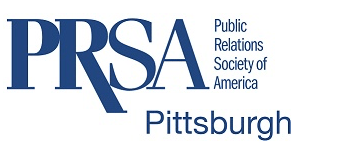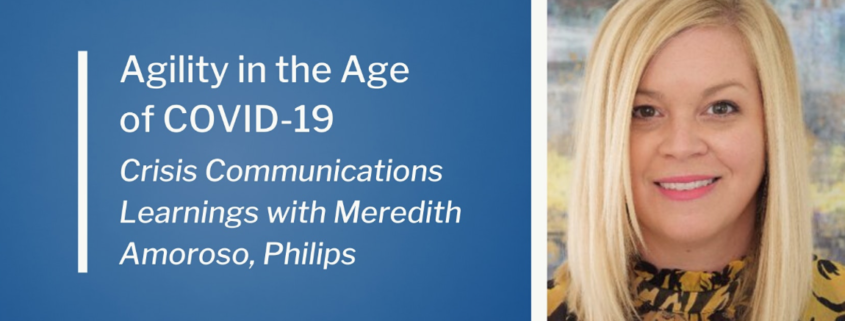Consider a crisis as a learning opportunity, not an inconvenience
Senior PR manager at Philips reflects on how ventilator demand during COVID-19 shifted the company’s strategy – and what others can take away from it
By Stacey Federoff
Web Content Manager
On Thursday, May 28, PRSA Pittsburgh hosted “Agility in the Age of COVID-19”, an informal virtual discussion with Meredith Amoroso, a senior manager of public relations in Philips Global Press Office and former PRSA Pittsburgh Chapter President. Led by Andrew Conte, director of the Point Park Center for Media Innovation, the two dove into crisis communications learnings influenced by the COVID-19 pandemic.
Amoroso saw first-hand how the demand for ventilators during the COVID-19 pandemic had taken a toll on employees at Philips Sleep and Respiratory Care.
“I was emotional on a number of occasions, meeting these people who you could tell were just exhausted, but didn’t care. They wanted to be there, they wanted to do the work,” she said. “They said, ‘I’m just glad to be here, I’m glad I can do my part.’ ”
Philips’ Pittsburgh connection
Originally founded as Respironics – the first to develop a continuous positive airway pressure (CPAP) machine for the treatment of sleep apnea, Philips Sleep and Respiratory Care has since 2009 been a Murrysville-based arm of the health technology company headquartered in The Netherlands.
In January, the company, which focuses on health technology, saw the demand for ventilators begin to rise as cases of COVID-19 rose in China, and with it the company’s production rose too, Amoroso said. The communications team began an initial strategy, well before early March as coronavirus cases hit the United States.
“How can we be very transparent and communicate what we’re doing to meet the evolving needs all over the world of these pieces of medical equipment?” is what the team focused on, she said.
When coronavirus hit
First, with offices and manufacturing facilities in China, the company focused on internal communications to keep “business continuity while keeping our employees and our customers really safe.” This included emphasizing social media and media protocols, in case anyone was approached by journalists, to balance employees’ pride in their work with safety in high-risk situations like hospitals treating COVID-19 patients.
For external communications, “it’s extremely difficult to prepare for the complete unknown,” instead Amoroso said she and the team had a clear understanding of what steps the company was taking, thanks in part to access to the highest executive leadership at the company.
“Our teams worked day and night to innovate and develop an emergency-use ventilator,” she said. “Something that usually takes years and years of ideation and conceptualization and production, we were able to create something in just a matter of weeks that still met all the stringent medical standards. We wanted to tell that story, we wanted to talk about how … the employees at Philips came together to create something that could fill an existing gap in accessibility to ventilators worldwide.”
Remain agile
This pandemic has caused a shift in thinking, so it has altered communications strategies as well – and not only how people themselves are experiencing it, but also how journalists are covering it, and how PR pros should describe their businesses to people. “We just have to remain agile and change the way we’re talking about [things].”
Particular to her industry, Amoroso said the cancellation of trade shows meant thinking about how to build relationships differently, where otherwise she would be pitching and sending press releases to journalists. Now she’s sending “tickler” emails and making phone calls – maybe to say hello and reference something posted on LinkedIn – just to touch base with press because she doesn’t get to have those one-on-one interactions.
Here are other takeaways that Amoroso shared during the event for communicators in a crisis:
- Find ways to create a team. Even as the only PR person at a small company, you can make a difference during a crisis by bouncing ideas off people in different departments. But be sure to assert yourself to ask the right questions and make recommendations that you feel are the right call.
- Use background for interviews, like holding statements and briefing documents, to help guide executives during a crisis. This will help them understand each journalist and their background, Amoroso said, even if it’s only LinkedIn or MuckRack profiles with past stories.
- When you don’t know an answer, be transparent and remain in communication with who’s asking it. “Communicate, let them know we’re here for them,” she said. Be aware of journalists’ deadlines.
- “Don’t always think you know what you’re doing” and “be willing to learn,” she said. Take a crisis as a learning opportunity, not an inconvenience. “You can’t prepare for the impossible, but know your product or your business very well.” So when a reporter asks, you can “respond at a high level and make them feel heard” allowing the company to be a part of the conversation.
- During a crisis, “you have to find things that make you proud of the company you represent and make you proud of the position that you’re in,” she said. Sometimes that means considering strategies that change the prevailing narrative.
- Balance telling the business side of the story with the human side of the story: “We were able to pull that together and tell some human interest stories that I think honestly have been some of the most popular pieces of content that we put out there so far.”
For more insights, such as how she and her team faced a challenge, watch a recording of the event below and on our YouTube page.
Read about our follow-up event: Navigating the Job Search During COVID-19 Times
Sign up for our newsletter to be the first to hear about these kinds of events.





Nice post and takeaways, Stacey!